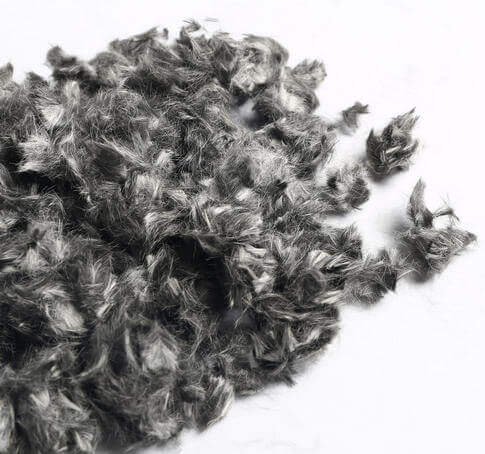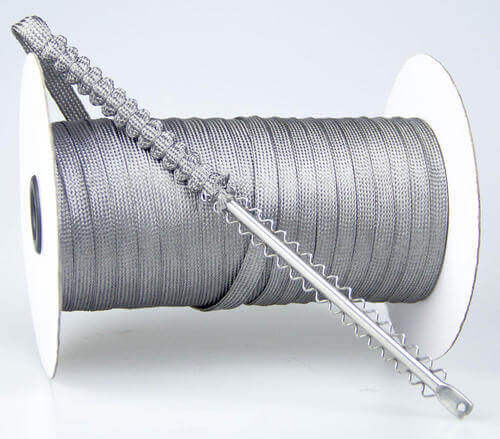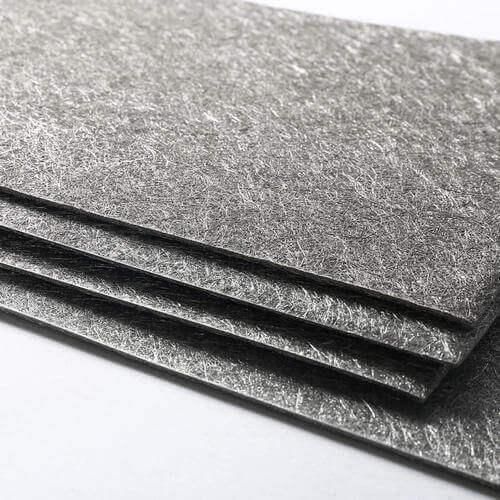When it comes to tough filtration jobs, stainless steel sintered fiber felt is the material you need, but many are still in the dark about its full potential. How does it withstand high pressures and extreme temperatures? Why is it so reliable for filtering fine particles? In this guide, we’ll answer these questions and more. We’ll explain what sintered fiber felt is, how to choose the right type based on micron rating and porosity, and dive into its key characteristics like high dirt-holding capacity and corrosion resistance. We’ll also cover real-world applications, from polymer filtration to aerospace, and explore how it offers cost savings through cleanability and reusability. Ready to unlock the secrets of this versatile material? Let’s dive in!

What is Stainless Steel Sintered Fiber Felt?
Stainless steel sintered fiber felt is a high-performance, non-woven filtration medium made through sintering and bonding short stainless steel fibers. This process creates a porous structure with evenly distributed pores, allowing for efficient filtration and fluid flow.
The material is highly durable and offers high temperature resistance (from 300°C to 1200°C), corrosion resistance, and mechanical strength, making it ideal for filtering high-viscosity fluids and gases in demanding environments. Its high porosity and uniform pore size distribution prevent clogging and damage, ensuring reliable performance even under pressure.
Used in applications such as polymer filtration, gas filtration, liquid purification in industries like pharmaceuticals and petroleum, and even aerospace and automotive systems, sintered fiber felt provides superior dirt holding capacity and improved flow characteristics. It’s easy to clean and reusable, making it a cost-effective and eco-friendly solution for long-term use.
How do you Choose 316L Stainless Steel Sintered Metal Fiber Felt Media?
When selecting 316L stainless steel sintered metal fiber felt, focus on the following factors:
- Micron Rating: Determines the particle size the filter captures. A finer micron rating filters smaller particles but may increase pressure drop.
- Porosity: Higher porosity allows better flow and reduces pressure drop while improving the filter’s dirt-holding capacity.
- Permeability: Higher permeability is ideal for applications with high flow rates.
- Filtration Area: A larger filtration area handles higher flow rates and maintains efficiency.
- Flow Rate, Pressure, and Temperature: Ensure the filter can withstand the system’s operating conditions.
- Compatibility: The filter media must be compatible with the fluid and contaminants it will filter.
- Sealing Configuration: Ensure proper sealing to prevent bypass and ensure effective filtration.
- Filtration Accuracy: Match the desired particle removal level with the filter’s micron rating.
- Cleaning Requirements: Choose a filter that’s easy to clean to reduce maintenance and downtime.
316L Stainless Steel is chosen for its corrosion resistance, especially in harsh environments or hygiene-critical applications. The sintering process creates a robust, durable structure with multiple pore sizes, offering a combination of high dirt-holding capacity and precise filtration.
This type of metal fiber felt is commonly used in petrochemical, water treatment, and metallurgy industries, where durability and performance under harsh conditions are crucial. The sintering process also enhances strength, making it resistant to thermal shock and improving overall longevity.
Where can I use Stainless Steel Sintered Fiber Felt?
Stainless steel sintered fiber felt is ideal for liquid and gas filtration across various industries, especially in high-temperature environments. It is commonly used in:
- Polymer Filtration: Purifying polyester melts and polymer streams.
- Pre-Filtration & Refining: Used as pre-filters in ultrafiltration systems and in refining processes.
- High-Temperature Gas Dust Removal: Perfect for filtering gases in electronics and other high-heat applications.
- Liquid Purification: In industries like pharmaceuticals, petroleum, and food processing for effective liquid filtration.
- Support & Protection: Acts as support for filter membranes and protects vacuum pumps.
- Automotive & Aerospace: Found in car airbags and fuel filtration systems for aircraft and ships.
- Other Applications: Used in catalyst recovery, hydraulic filtration, and certain nuclear applications.
This versatile material’s strength, heat resistance, and filtration efficiency make it indispensable for these demanding applications.
What are The Advantages of Stainless Steel Sintered Fiber Felt?
Stainless steel sintered fiber felt offers numerous benefits that make it ideal for demanding filtration applications. Here are its key advantages:
- High Filtration Efficiency: The material effectively captures particles of various sizes, providing excellent filtration performance for both fine and deep filtration.
- High Dirt Holding Capacity: Its structure allows it to trap large amounts of particulate matter, extending the time between cleanings or replacements.
- High Porosity and Permeability: With high porosity, the felt supports high flow rates and minimizes pressure drop, ensuring efficient filtration.
- Precise Pore Size Control: The sintering process enables exact control over pore size, allowing customization to meet specific filtration needs.
- Durability and Resistance:
- Corrosion Resistance: Stainless steel’s natural resistance to corrosion makes the felt ideal for harsh chemical environments.
- High Temperature Resistance: It can withstand high temperatures, making it perfect for heat-intensive applications.
- Pressure Resistance: The material can handle high-pressure differentials, ideal for systems with fluctuating pressure.
- Corrosion Resistance: Stainless steel’s natural resistance to corrosion makes the felt ideal for harsh chemical environments.
- Cleanability and Reusability: The porous metal filter can be easily cleaned and reused, reducing long-term costs and waste. This is particularly beneficial for systems where filters need to be maintained regularly.
- Customizability: Stainless steel sintered fiber felt can be made in various thicknesses, pore sizes, and shapes to suit specific applications.
- Cost-Effectiveness: The combination of durability, high performance, and ease of maintenance makes it a cost-effective solution in the long run, reducing the need for frequent replacements and lowering operational costs.
These benefits make stainless steel sintered fiber felt a reliable, long-lasting, and efficient filtration medium across industries.

What are the Characteristics of Stainless Steel Sintered Fiber Felt?
Stainless steel sintered fiber felt is known for its high porosity, excellent permeability, and durability. These characteristics make it ideal for a wide range of filtration applications. Key features include:
- High Filtration Efficiency: The porous structure captures fine particles while allowing for high flow rates.
- Corrosion and High-Temperature Resistance: Made from stainless steel, it resists corrosion and can withstand high temperatures, making it suitable for harsh environments.
- High Dirt Holding Capacity: The felt can trap a large amount of particulates before requiring cleaning, extending service life.
- Low Pressure Drop: Its high porosity ensures low resistance to flow, improving efficiency.
- Strength and Durability: The sintered process creates a robust structure that resists pressure, thermal shock, and mechanical stress.
- Customizability: The material can be tailored in pore size, shape, and dimensions to meet specific needs.
- Easy to Clean: It can be cleaned using backflushing or other methods, making it reusable and cost-effective.
- Weldable and Machinable: Its large filter area allows for easy integration into systems through welding or machining.
These features make stainless steel sintered fiber felt a versatile and reliable filtration solution for various industrial applications.

What Is the Role of Stainless Steel Sintered Fiber Felt?
This is mainly used for industrial and heavy-duty filtration processes such as polymer filtration and polyester melt purification.
- Vacuum pump protection filter, filter membrane support, catalyst carrier.
- Hydraulic system filtration.
- Filtration of the refining process, pre-filtration of an ultrafilter.
How do you Choose Stainless Steel Sintered Fiber Felt?
When choosing stainless steel sintered fiber felt, consider the micron rating, which determines the particle size the filter captures. A finer rating offers better filtration but may reduce flow rate. Porosity and permeability are important for maintaining high flow rates and minimizing pressure drop, while ensuring good dirt-holding capacity. Make sure the felt can handle the flow rate and pressure of your system without compromising performance.
The temperature resistance and material compatibility are key—stainless steel resists heat and corrosion, but alloys like 316L may be needed depending on the application. Filtration area is also essential; larger areas accommodate higher flow rates and greater contaminant loads.
Cleanability and reusability are advantages of sintered fiber felt. Consider how often cleaning is needed and which methods are suitable. Evaluate the system requirements, such as filtration accuracy and filter size, and check the material’s strength and corrosion resistance for your application. If necessary, consult with a filtration expert or test a small sample before making your final selection.
By focusing on these factors, you can choose the best sintered fiber felt for your needs.
What is the Temperature Range of Stainless Steel Sintered Fiber Felt?
It has a high temperature ranging from 300°C to 1200°C.
Can I Clean Stainless Steel Sintered Fiber Felt?
Yes, it can, in the features of sintered fiber felt we mentioned that it is easy to clean and can last for long periods of time.
Amazingly, the stainless steel sintered fiber felt is easy to clean. This will come as a relief, as there might be a headache after the job this item undergoes. Do not also forget that this felt can be welded and machined because of its large filter area.
You can easily free porous metal filters of particulate by using backwash cleaning methods − without scraping, scrubbing, or rotating filter elements. You can also remove contaminants with water, steam, air, solvents, caustic or acid washing, or with ultrasonic cleaning.
What is the Size Range of Stainless Steel Sintered Fiber Felt?
It ranges from 1100mm x 500mm to 1250mm x 1000mm.
Due to the different types of work to be performed, its specific size is selected according to your field application.
In Which Liquids can you use Stainless Steel Sintered Fiber Felt?
Different sectors make use of fiber felt, and each sector uses it differently. Here are some examples of liquids that are filtered in different sectors using sintered fiber felt.
Chemical and Petrochemical Sector – catalyst recovery, polishing of corrosive liquids, pre-coat filtration
Refinery – the high rate of liquid flows in the refinery is filtered by fiber felt Food and Beverages – polishing of syrups, liquors and other liquids
If you work in any chemical industry or own one, you should suggest that your industry gets this filter as it will be helpful.
Can Stainless Steel Fiber Felt Media Provide Surface Filtration and Depth Filtration?
Sintered fiber felt provides both surface and depth filtration.
Our filter media enables you to achieve high efficiency through filter cake accumulation (surface filtration), and also provides high dust collection capacity for deep particle capture (depth filtration).
Conclusion
At this point, no one will hold you in a negative light for thinking if there is anything in the world that does not require the stainless steel felt. After all, filtration is an essential aspect of life that we cannot underplay. The role of the metal fiber felt in burners is to ensure that there is proper combustion and gives you the perfect output which you desire.
Also, with the knowledge gotten about stainless steel fiber felt, we hope you can differentiate it from others as this article has highlighted its uses, and the size it comes in.
Always keep in mind that you should choose a felt based on the purpose of the job you are doing. If you are going for anything that needs an industrial process, the stainless steel felt should be your first and only choice.
With all the knowledge of this article, it is hopeful that you do not seem lost the next time people are talking about the metal fibre felt or its components.